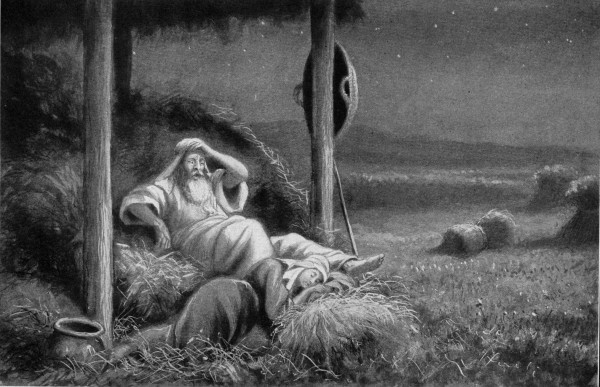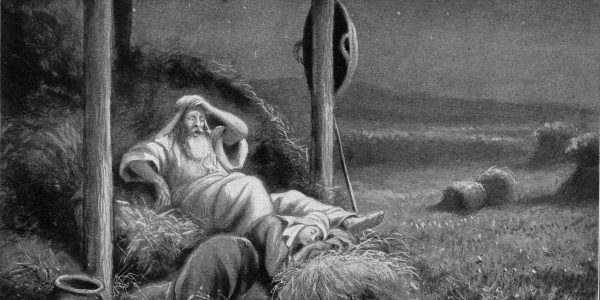It is well known to those who give the Book of Ruth even a cursory reading that Boaz is older than Ruth and, in fact, is closer to Naomi in age. In the comments of a paper on Boaz that I posted here over a year ago, Robert Holmstedt, who has a great book on the subject, Ruth: A Handbook on the Hebrew Text, pointed to some of his own work in which he noted that the “antiquated” language in the book is often in the mouths of Naomi and Boaz.
In my Baylor Handbook I considered 7 features (oddly, I now see that I discussed the paragogic nun elsewhere, although it fits at this point as well) and drew this conclusion (2010:49):
“These seven features are, in my opinion, best understood as part of the story-teller’s creativity and linguistic artistry. And yet they are not simply literary window-dressing. It is no accident that five of the seven features are in the mouths of No‘omi and Boaz, while only one is use in Ruth’s speech. The narrator set up a light ‘linguistic curtain’ with the audiencea on one side and No‘omi and Boaz on the other. The implication is that, while they audience is reminded throughout the Ruth is a foreigner, they are also encouraged, by linguistic means, to identify with her. Although No‘omi is the story’s protagonist and her redemption is an important theological message, Ruth is the heroine of the story and it is her courage and loyalty that the audience is encouraged to take in the most deeply. No‘omi may have been re-filled by God, but God has provided for Ruth across cultural and political boundaries — an important reminder for the Israelites at many historical points.”
(Robert was hoping to produce an article on this for the fall of 2010. Did you get that published Robert? I would love to see it! UPDATE: I did find this paper on his Academia page: Dating the Language of Ruth: A Study in Method)
In his Anchor Bible Commentary volume on Ruth, Edward Campbell spends quite a bit of time commentating on Boaz’s age, noting that everyone in chapter two is referred to as being old, in reference to Boaz; the young men, Ruth is a “young woman” (הַנַּעֲרָה) in Ruth 2:5, and of course Boaz’s “young women” whom Ruth is to follow.

In chapter 3 we have the famous scene at the threshing floor when Ruth uncovers Boaz’s “feet.” When Boaz wakes he commends her, saying,
May you be blessed by the LORD, my daughter; this last instance of your loyalty is better than the first; you have not gone after young men, whether poor or rich.
Clearly Boaz is older, perhaps much older, than Ruth. Campbell concludes his musings on this matter by asking, “What purpose is there behind these devices?”
One senses that the story-teller means to give his characters a certain credibility in this way. Perhaps also there is a need, especially in the case of Naomi, to underscore the truth of her own assertion in 1:12 that she is too old to have a husband. As for Boaz there may even be a question about his ability to a sire a son. …In any event, senior citizens they [Naomi and Boaz] are, and the audience should appreciate them as such. [mfn]Campbell, pp. 110-1.[/mfn]
Keeping this in mind, consider the curious description of the birth of Ruth’s son, Ruth 4:16-7.
Then Naomi took the child and laid him in her bosom, and became his nurse (וַתְּשִׁתֵהוּ בְחֵיקָהּ וַתְּהִי־לוֹ לְאֹמֶנֶת). The women of the neighborhood gave him a name, saying, “A son has been born to Naomi.”
I have always found the description of Naomi becoming Obed’s “nurse” very odd. True, the Hebrew text describes her as a “foster-mother” (וַתְּהִי־לוֹ לְאֹמֶנֶת) rather than as a wet nurse (אִשָּׁה מֵינֶקֶת), but the fact that she is described as laying him on her bosom and that they women say a son has been born to Naomi… Well it just makes a fella think.
What I am beginning to wonder is if the marriage between Ruth and Boaz was more of a marriage of convenience than previously thought. We all know that Boaz married her for, on a basic level, the purpose (as confused as the legal situation is) of maintaining the name of Mahlon and providing for these two widows. But when I consider that Naomi and Boaz were contemporaries and significantly older than Ruth (I am not sure I would say that they are “senior citizens” since in our modern context that would mean to most well over 60, something unlikely in the time period) then I begin to wonder if Naomi and Boaz are the real romance and that the women of the town knew that this was the case. Naomi cannot produce a child and Ruth needs to be provided for so and protected so Boaz marries Ruth, but his heart belongs to Naomi. [mfn]Too schmaltzy? Yes, but this is a blog and as I have noted elsewhere, context allows one to be more casual in some contexts than in others.[/mfn]
I am by no means convinced that this idea has any merit. If Naomi and Boaz were the real love interests, then why did Boaz just not marry Naomi? While Machlon’s name may not have been “preserved” Elimelech’s would have been and the property would have remained in the family. Still, I wonder if these different threads of the story should not be woven together in some fashion….



15 thoughts on “Age in the Book of Ruth and a Proxy Marriage?”
Hi Chris,
The article remains on my project list. After commenting on your post last year, I wrote Gary Rendsburg and we agreed to write the article together … eventually. (We both have a lot on our respective plate.)
It’s interesting (but not surprising) that every time I go back to Campbell’s commentary I am impressed how insightful it is. In many ways, even the article that Gary and I may write is an extension (and linguistic formulation) of things that Campbell noticed.
Intriguing idea on Boaz and No’omi. Hmmm ….
(Oh, and the quote from my book made my heart stop with the typos. I had to get a printed copy out and check — thank goodness those typos aren’t in the final version!)
Thanks Robert! Campbell’s commentary is very rich. As for my suggestion, it is hardly a water tight argument, but I think it is worth thinking about.
Chris,
I’m certainly not opposed to your idea.
I’m sitting here trying to sort through how we’d determine whether the identification of Obed as No’omi’s “son” is purely a literary artifice to serve the larger theme of “re-filling” No’omi or whether it reflects, as you suggest, nuances of the relationships that the narrator has developed between the characters (i.e., that the primary romance is between Boaz and No’omi).
By the way, nice job on the Targum translation!
.
This is a new thought. Intriguing. But perhaps “her bosom” is just what a grandparent has. It is a widely used expression, for God and Christ in John 1, a shepherd carries the sheep in his bosom, and Moses uses it here, “Have I conceived all this people? have I begotten them, that thou shouldest say unto me, Carry them in thy bosom, as a nursing father beareth the sucking child, unto the land which thou swarest unto their fathers?”
I am not sure that this expression sexualizes Naomi in the Hebrew, in the way that “breast” would in English. I would be all in favour of a romance for Naomi here, but I just don’t see it. I think the desire for grandchildren would predominate.
Thank you again Sue. I will reply to your comments on the other post later. On this matter you are certainly correct, “bosom” has a very broad meaning as does “nurse” (it can mean to suckle or to care for one, of course). I am not thinking of it as sexualizing, rather this use of both terms along with the announcement that a son had been born “to Naomi” is what is intriguing to me.
Now I will be the first to admit that this is a far reaching reading of the text. If it is there at all, it is the merest hint, a whisper of a relationship.
I will follow with interest.
As I see it, the basic problem to be solved in the storyline of Ruth is that the 3 women are man-less in patriarchal societies. The 2 young women can get re-married and be provided for, but what is Naomi to do? Her prospects are very bleak.
Ruth comes to her rescue. This is very unexpected as Ruth is a Moabitess. Naomi tries to disuade her (quoting from the Naomi school of evangelism (smile)), but Ruth still declines to go her own way. And it all works out in the end, as Naomi ends up with a son (a male) who will be able to take care of her in her old age, so she is no longer man-less.
And the subtext is: Was David a legitimate king of Israel? Who would dare say no, therefore those who join in faith with Israel and Israel’s God (like Ruth did) should be considered part of Israel.
Don – without a doubt the basic plot line is, “how will these women survive?” (That in itself is founded and necessitates a patriarchal society.) It is common to state the subtext is the legitimacy of David’s lineage, but it is equally common to attribute the text to a much later date, circa Ezra’s reforms. Can there not be other subtexts? Other counterpoints and arguments being made?
Hi, I’m sorry I could not find an email address hence i have posted here. I am kindly asking for permisison to use the Boaz image in a book that I am writing.
Tina,
The image is, if I am not mistaken, from Horne’s “The Bible and Its Story” by Horne. It is a 1909-1910 publication and out of copyright so it should be fair game for use.
What is the book you are writing?
I love this story, many biblical truths unfold here. This marriage also symbolizes or foreshadows Jesus Christ bringing together God’s chosen people and the Gentiles.
I’ve heard others opions of their age differences , of 40 years ( a few times ) and once of 50years .
Story of Ruth is never the less Very inspiring.
you do not understand Jewish law- a baby needed to be born to preserve the line of Naomi’s husband. Naomi could no longer have children.
See now my fuller post with bibliography here.
Dee Dee, thank you for your curt note. I do understand Jewish law, at least relating to the Book of Ruth. First, we should make a distinction between “Jewish Law” (“halakhah”) and Biblical Law. The latter, obviously, refers to the Law found in the Bible, in this case the relevant passages are Deut. 25:5-10 and Lev. 25:24-34. The former refers to Jewish Law the post-dates the Bible, such as the Mishnah and Talmud, specifically, the tractate Yevamot. Now, in the case of the Book of Ruth, there is considerable debate about what, legally, is going on with Boaz and Naomi/Ruth. A quick perusal of a critical commentary will bring this out, but I will summarize here.
Naomi says Boaz is a הָאִישׁ מִגֹּאֲלֵ, a “kinsman redeemer.” The relevant biblical law here is Lev. 25:24-34. The issue is that the property should remain within the family. This seems to be the only legal issue at hand. Presumably, but not certainly, there was property that Elimelech owned which Naomi could sell to provide for their needs. Boaz is a near kinsman and would have the first (or as we find out, the second) right of refusal. So why does he marry Ruth?
It would seem that Deut. 25:5-10 is being invoked, what is known as “levirate marriage.” That term is from Latin, “levin” for “husband’s brother.”
And that is the difficulty, Boaz is NOT Elimelech’s brother. Boaz, nor “so-and-so,” was under any obligation to marry Naomi. And it would be Naomi, not Ruth who should be married anyway. Biblical law obliges the near kinsman to “redeem” their property so that it stays within the clan, but the obligation of marriage is reserved for the husband’s brother. So, Boaz has NO obligation to marry Ruth, according to the biblical law.
This is why the legal issues with the Book of Ruth are so perplexing. It is not in keeping with biblical law as preserved in the canonical texts. A few possibilities arise from that fact. Is the Book of Ruth reflecting the practice of local law at the time of writing? This would be distinct from the written law and, perhaps, even ignorant of it. Is the Book of Ruth thus descriptive of local practices and customs (e.g., the sandal issue) and Deuteronomy and Leviticus prescriptive? (The latter is certainly true. The legal texts represent how things ought to work, even if they never did work that way.) Or was the author of Ruth simply weaving the tale in such a way as to create audience interest and tension in the narrative?
So, it is not such a simple legal situation after all. And I have not even touched on the rabbinic halakhah in Babli Yevamot…